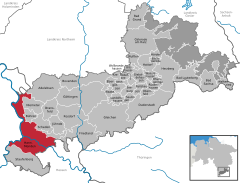Hannoversch_Münden
Hann. Münden
Town in Lower Saxony, Germany
Hann. Münden (short for Hannoversch Münden) is a town in Lower Saxony, Germany. Münden lies in the district of Göttingen at the confluence of the Fulda and Werra rivers, which join to form the Weser. It has about 24,000 inhabitants (2013). It is famous for its half-timbered houses, some of them more than 600 years old. There are 10 million cobblestones around the town.
You can help expand this article with text translated from the corresponding article in German. (March 2013) Click [show] for important translation instructions.
|




